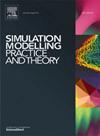基于模块化组态的智能制造系统快速验证与验证框架
IF 3.5
2区 计算机科学
Q2 COMPUTER SCIENCE, INTERDISCIPLINARY APPLICATIONS
引用次数: 0
摘要
验证和确认(V&;V)是制造系统从设计到运行过程中确保准确性、安全性和可靠性的关键步骤。随着智能制造技术的发展和市场变化的加速,制造系统的复杂性和灵活性不断提高,开发周期不断缩短。这些都提高了V&;V的综合性、效率和自动化要求。然而,现有的V&;V方案和案例并不能充分发挥分析方法和仿真方法的互补优势。难以满足复杂智能制造系统的有效V&;V要求。本研究结合分析与仿真方法,提出了一种基于模块化配置的制造系统V&;V框架,用于制造系统的快速V&;V。探讨了制造系统模块化结构的构建方法。模块化配置分为组件功能子配置、系统逻辑子配置和联合模型子配置,并基于AAS (Asset Administration shell)进行模块化封装和集成。建立了制造系统的快速V&;V工艺。该过程采用测试模块驱动的方法来实现制造系统的基于配置的V&;V测试。它支持与循环中的设备、软件和模型进行同步联合仿真。最后,给出了一个简单的制造系统V&;V实例作为实现参考。该框架可以展示智能制造系统的快速V&;V,并有助于自动化V& &;V工具的开发。本文章由计算机程序翻译,如有差异,请以英文原文为准。
A modular configuration-based rapid verification and validation framework combining analytical and simulation methods for intelligent manufacturing systems
Verification and Validation (V&V) are crucial steps in the design to operation process of manufacturing systems to ensure the accuracy, safety, and reliability. The development of intelligent manufacturing technology and the acceleration of market changes are driving the increase of complexity and flexibility of manufacturing systems and the shortening of development cycles. These enhance the comprehensiveness, efficiency, and automation requirements of V&V. However, existing V&V schemes and cases cannot fully utilize the complementary advantages of analytical and simulation methods. It is difficult to meet the effective V&V requirements of complex intelligent manufacturing systems. This study proposes a modular configuration-based manufacturing system V&V framework combining analytical and simulation methods for rapid V&V of manufacturing systems. The construction method of modular configurations of manufacturing systems is explored. The modular configuration has been divided into the component function, system logic, and joint model sub-configurations and modularly packaged and integrated based on Asset Administration Shells (AAS). A rapid V&V process for manufacturing systems has been established. This process employs a test-module-driven approach to achieve configuration-based V&V testing of manufacturing systems. It supports synchronized co-simulation with equipment, software, and models in the loop. Finally, a simple manufacturing system V&V case was provided as an implementation reference. The proposed framework can demonstrate the rapid V&V of intelligent manufacturing systems and contribute to the development of automated V&V tools.
求助全文
通过发布文献求助,成功后即可免费获取论文全文。
去求助
来源期刊

Simulation Modelling Practice and Theory
工程技术-计算机:跨学科应用
CiteScore
9.80
自引率
4.80%
发文量
142
审稿时长
21 days
期刊介绍:
The journal Simulation Modelling Practice and Theory provides a forum for original, high-quality papers dealing with any aspect of systems simulation and modelling.
The journal aims at being a reference and a powerful tool to all those professionally active and/or interested in the methods and applications of simulation. Submitted papers will be peer reviewed and must significantly contribute to modelling and simulation in general or use modelling and simulation in application areas.
Paper submission is solicited on:
• theoretical aspects of modelling and simulation including formal modelling, model-checking, random number generators, sensitivity analysis, variance reduction techniques, experimental design, meta-modelling, methods and algorithms for validation and verification, selection and comparison procedures etc.;
• methodology and application of modelling and simulation in any area, including computer systems, networks, real-time and embedded systems, mobile and intelligent agents, manufacturing and transportation systems, management, engineering, biomedical engineering, economics, ecology and environment, education, transaction handling, etc.;
• simulation languages and environments including those, specific to distributed computing, grid computing, high performance computers or computer networks, etc.;
• distributed and real-time simulation, simulation interoperability;
• tools for high performance computing simulation, including dedicated architectures and parallel computing.
 求助内容:
求助内容: 应助结果提醒方式:
应助结果提醒方式:


